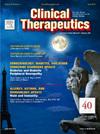Trofinetide在小儿Rett综合征人群中的安全性:一项现实世界上市后药物警戒分析。
IF 3.6
4区 医学
Q2 PHARMACOLOGY & PHARMACY
引用次数: 0
摘要
目的:Trofinetide是一种合成的甘氨酸-脯氨酸-谷氨酸类似物,是唯一被批准治疗Rett综合征的药物。本研究利用真实世界的药物警戒数据评估了特非尼肽在Rett综合征患儿中的安全性。方法:从美国食品药品监督管理局不良事件报告系统(FAERS)中提取2023年第一季度至2024年第四季度的不良事件(AE)报告。使用ROR、PRR、BCPNN和MGPS进行歧化分析,检测与18岁以下个体使用特非尼肽相关的AE信号。采用威布尔分布模型评估发病时间模式。根据年龄和剂量进行亚组分析,以及排除常见联合用药的敏感性分析,以评估信号一致性。结果:大多数患者为女性(95.4%),所有报告均来自美国。常见标记不良事件包括腹泻(n = 1528, ROR = 38.1)、呕吐(n = 434, ROR = 5.96)和癫痫发作(n = 251, ROR = 5.30)。说明书外信号包括体重下降(n = 135; ROR = 7.21)、震颤(n = 39; ROR = 3.37)、肌张力障碍(n = 18; ROR = 4.39)和运动障碍(n = 24; ROR = 4.53)。超过70%的ae发生在第一个月内。嗜睡在年幼儿童中更为常见(ROR = 12.11),高剂量与精神症状相关。亚组分析和敏感性分析证实了关键信号的稳健性。意义:本研究提供了在儿童Rett综合征中使用trofinetide的关键现实世界安全性数据,确定了预期的和新出现的ae。研究结果强调了在临床环境中监测剂量相关和年龄特异性不良事件的重要性。本文章由计算机程序翻译,如有差异,请以英文原文为准。
Safety Profiles of Trofinetide in Pediatric Rett Syndrome Population: A Real-World Postmarketing Pharmacovigilance Analysis
Purpose
Trofinetide, a synthetic analog of glycine-proline-glutamate, is the only approved therapy for Rett syndrome. This study evaluated the safety profile of trofinetide in pediatric patients with Rett syndrome using real-world pharmacovigilance data.
Methods
Adverse event (AE) reports were extracted from the U.S. Food and Drug Administration Adverse Event Reporting System (FAERS) from Q1 2023 to Q4 2024. Disproportionality analyses were conducted using ROR, PRR, BCPNN, and MGPS to detect AE signals associated with trofinetide use in individuals under 18 years. A Weibull distribution model was applied to assess time-to-onset patterns. Subgroup analyses by age and dose, as well as sensitivity analyses excluding common co-medications, were conducted to evaluate signal consistency.
Findings
Most patients were female (95.4%), and all reports originated from the United States. Common labeled AEs were confirmed, including diarrhoea (n = 1,528; ROR = 38.1), vomiting (n = 434; ROR = 5.96), and seizures (n = 251; ROR = 5.30). Off-label signals included weight decreased (n = 135; ROR = 7.21), tremor (n = 39; ROR = 3.37), dystonia (n = 18; ROR = 4.39), and dyskinesia (n = 24; ROR = 4.53). Over 70% of AEs occurred within the first month. Hypersomnia was more frequently reported in younger children (ROR = 12.11), and higher doses were associated with psychiatric symptoms. Subgroup and sensitivity analyses confirmed the robustness of key signals.
Implications
This study provides critical real-world safety data on trofinetide use in pediatric Rett syndrome, identifying both expected and emerging AEs. Findings highlight the importance of monitoring dose-related and age-specific adverse events in clinical settings.
求助全文
通过发布文献求助,成功后即可免费获取论文全文。
去求助
来源期刊

Clinical therapeutics
医学-药学
CiteScore
6.00
自引率
3.10%
发文量
154
审稿时长
9 weeks
期刊介绍:
Clinical Therapeutics provides peer-reviewed, rapid publication of recent developments in drug and other therapies as well as in diagnostics, pharmacoeconomics, health policy, treatment outcomes, and innovations in drug and biologics research. In addition Clinical Therapeutics features updates on specific topics collated by expert Topic Editors. Clinical Therapeutics is read by a large international audience of scientists and clinicians in a variety of research, academic, and clinical practice settings. Articles are indexed by all major biomedical abstracting databases.
 求助内容:
求助内容: 应助结果提醒方式:
应助结果提醒方式:


